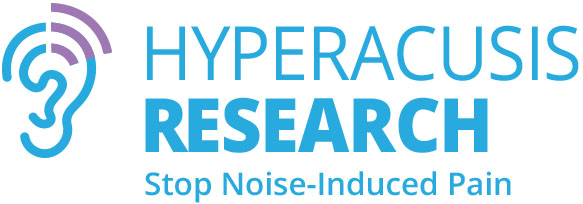At Hyperacusis Research Limited, Inc., we are committed to improving the quality of life for patients who suffer from hyperacusis.
There are different definitions of hyperacusis. In studying these variations, Adams et al. (2020) present this consensus definition of hyperacusis: “A reduced tolerance to sound(s) that are perceived as normal to the majority of the population or were perceived as normal to the person before their onset of hyperacusis”.
We concur with this consensus definition and focus specifically on the type of hyperacusis wherein sufferers find ordinary, everyday sounds to be unbearably loud and/or physically painful. We use the terms “loudness hyperacusis” and “pain hyperacusis,” respectively, to describe these two primary symptoms. Pain hyperacusis can also be referred to as “noxacusis” (Fuchs et al., 2015 and Beers Wood et al., 2024) Loudness and pain hyperacusis can occur together, and many patients report some degree of both. It is not clear whether these two categories of hyperacusis constitute two separate disorders or one disorder that exists on a continuum of severity.
Although we have yet to discover the biological underpinnings of loudness and pain hyperacusis, noise exposure (either long-term exposure or a single acoustic trauma) is believed to be the most common cause of acquired hyperacusis (reviewed in Jahn, 2022). Some patients also report hyperacusis following the administration of ototoxic medications, head or neck trauma, epidurals and spinal taps.
Core characteristics of loudness and pain hyperacusis
- Pain from sound. This can be immediate, delayed, or both.
- Amplified gain of sound, i.e., sounds feel louder than they should, and louder than before the onset of hyperacusis
- Further worsening from sounds that exceed a patient’s tolerance. These episodes of worsening, which the patient community sometimes refers to as setbacks, can last for days, weeks, months, or longer, or can even be permanent (Pollard, 2019, and Williams et al., 2021)
Additional symptoms that often occur alongside loudness and pain hyperacusis
- Tinnitus, or ringing in the ears
- Reactive tinnitus, or ringing in the ears that changes with exposure to environmental noise
- Aural fullness — an uncomfortable feeling of pressure or cloudiness within the ear, sometimes expanding to the scalp, face or neck
- Thumping or fluttering of the eardrum
- Perception of sounds as distorted or echoing
- Baseline burning ear pain (in silence, without sound), usually described as a feeling of acid, sunburn or sandpaper in the ear canal, with additional stabbing, jabbing pain upon noise exposure.
Prevalence of acquired loudness and pain hyperacusis
Population surveys have found that a large percentage of the adult general population reports “sensitivity to sound,” with estimates as high as 15.2% (reviewed in Jahn, 2022). However, existing prevalence studies do not consider the enormous variation in sound sensitivity symptoms or differences in underlying etiology (i.e., cause).
The prevalence of loudness and pain hyperacusis is unknown, but we can reasonably assume that it is far less than 15.2%. Hyperacusis Research and many patients with loudness and pain hyperacusis believe that the condition is extremely rare. However, we acknowledge that more research is needed in this area to determine the true prevalence.
A printable one page fact sheet on hyperacusis may be found here.
Conditions often confused with loudness and pain hyperacusis
Several other sound intolerance conditions are often confused with loudness and pain hyperacusis.
Misophonia. Misophonia is an emotional reaction, typically rage, panic or anger, to specific trigger sounds. Common triggers are human-generated sounds, such as breathing and chewing. People with misophonia may use sounds such as loud music, to drown out the trigger sounds. Up to 20% of the population is estimated to have some degree of misophonia (Wu et al., 2014). With a prevalence so large, misophonia likely accounts for many people who report sound sensitivity in the broad prevalence studies noted above.
Childhood sound sensitivity. Hyperacusis is poorly defined in children, but studies estimate that 3-17% of children have sound sensitivity (Rosing et al, 2016). At Hyperacusis Research, we typically focus on acquired loudness and pain hyperacusis, which many not apply to children with developmental etiologies of sound sensitivity.
Autism spectrum disorder (ASD). An estimated 1% of the population has ASD (Zeidan et al., 2022). As many as 70% of autistic people have experienced sound sensitivity at some point (Williams et al., 2021).
Myalgic encephalomyelitis (ME) /chronic fatigue syndrome (CFS). Of those diagnosed with ME/CFS, 15.3% are estimated to have sound sensitivity (Maeda et al., 2023).
Phonophobia. Phonophobia is an unwarranted fear of sound (Asha’ari et al, 2010), with psychological roots. Phobias are anxiety disorders that involve fear of something that presents little-to-no danger. The prevalence of phonophobia is unknown, but it is considered to be rare.
A number of other less common etiologies are associated with sound sensitivity symptoms, many of which are described in this comprehensive review of hyperacusis (Tyler et al., 2014, see Table 2).
